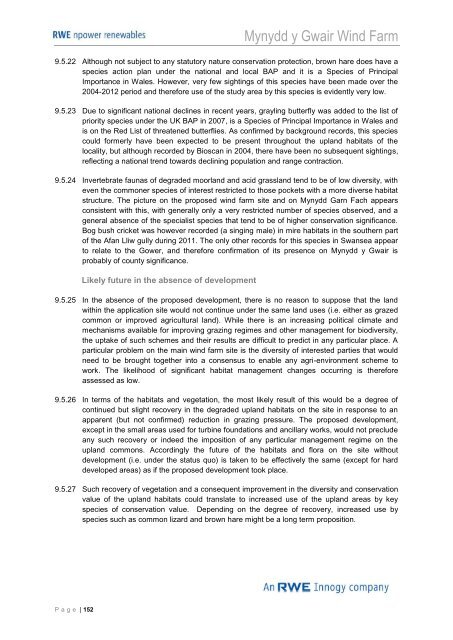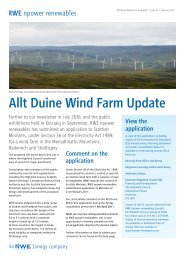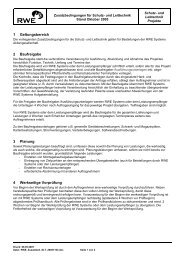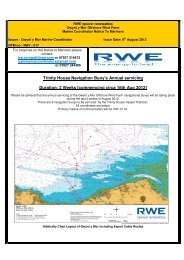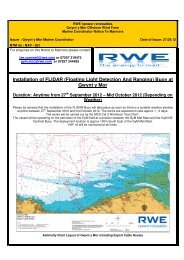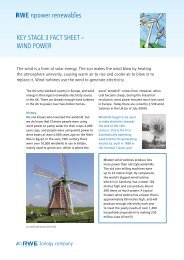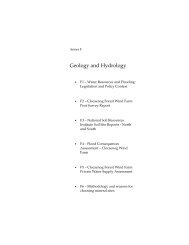Mynydd y Gwair Wind Farm - RWE.com
Mynydd y Gwair Wind Farm - RWE.com
Mynydd y Gwair Wind Farm - RWE.com
Create successful ePaper yourself
Turn your PDF publications into a flip-book with our unique Google optimized e-Paper software.
P a g e | 152<br />
<strong>Mynydd</strong> y <strong>Gwair</strong> <strong>Wind</strong> <strong>Farm</strong><br />
9.5.22 Although not subject to any statutory nature conservation protection, brown hare does have a<br />
species action plan under the national and local BAP and it is a Species of Principal<br />
Importance in Wales. However, very few sightings of this species have been made over the<br />
2004-2012 period and therefore use of the study area by this species is evidently very low.<br />
9.5.23 Due to significant national declines in recent years, grayling butterfly was added to the list of<br />
priority species under the UK BAP in 2007, is a Species of Principal Importance in Wales and<br />
is on the Red List of threatened butterflies. As confirmed by background records, this species<br />
could formerly have been expected to be present throughout the upland habitats of the<br />
locality, but although recorded by Bioscan in 2004, there have been no subsequent sightings,<br />
reflecting a national trend towards declining population and range contraction.<br />
9.5.24 Invertebrate faunas of degraded moorland and acid grassland tend to be of low diversity, with<br />
even the <strong>com</strong>moner species of interest restricted to those pockets with a more diverse habitat<br />
structure. The picture on the proposed wind farm site and on <strong>Mynydd</strong> Garn Fach appears<br />
consistent with this, with generally only a very restricted number of species observed, and a<br />
general absence of the specialist species that tend to be of higher conservation significance.<br />
Bog bush cricket was however recorded (a singing male) in mire habitats in the southern part<br />
of the Afan Lliw gully during 2011. The only other records for this species in Swansea appear<br />
to relate to the Gower, and therefore confirmation of its presence on <strong>Mynydd</strong> y <strong>Gwair</strong> is<br />
probably of county significance.<br />
Likely future in the absence of development<br />
9.5.25 In the absence of the proposed development, there is no reason to suppose that the land<br />
within the application site would not continue under the same land uses (i.e. either as grazed<br />
<strong>com</strong>mon or improved agricultural land). While there is an increasing political climate and<br />
mechanisms available for improving grazing regimes and other management for biodiversity,<br />
the uptake of such schemes and their results are difficult to predict in any particular place. A<br />
particular problem on the main wind farm site is the diversity of interested parties that would<br />
need to be brought together into a consensus to enable any agri-environment scheme to<br />
work. The likelihood of significant habitat management changes occurring is therefore<br />
assessed as low.<br />
9.5.26 In terms of the habitats and vegetation, the most likely result of this would be a degree of<br />
continued but slight recovery in the degraded upland habitats on the site in response to an<br />
apparent (but not confirmed) reduction in grazing pressure. The proposed development,<br />
except in the small areas used for turbine foundations and ancillary works, would not preclude<br />
any such recovery or indeed the imposition of any particular management regime on the<br />
upland <strong>com</strong>mons. Accordingly the future of the habitats and flora on the site without<br />
development (i.e. under the status quo) is taken to be effectively the same (except for hard<br />
developed areas) as if the proposed development took place.<br />
9.5.27 Such recovery of vegetation and a consequent improvement in the diversity and conservation<br />
value of the upland habitats could translate to increased use of the upland areas by key<br />
species of conservation value. Depending on the degree of recovery, increased use by<br />
species such as <strong>com</strong>mon lizard and brown hare might be a long term proposition.


